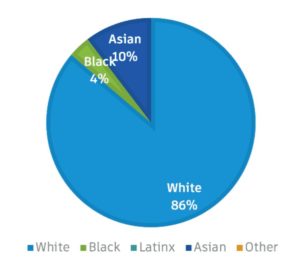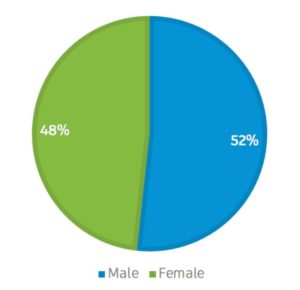The Autodesk Foundation is committed to accessible and transparent philanthropy
2020 was a year that challenged everyone’s resilience but also led organizations and teams to reflect on critical issues. At the Autodesk Foundation we spent time considering how the events of the year should inform our work and took inspiration from the efforts of the Diversity & Belonging team to look closely at how Diversity, Equity, and Inclusion (DEI) are tied to the Autodesk Foundation’s mission to support the design and creation of innovative solutions to the world’s most pressing social and environmental challenges.
As we begin the new fiscal year, we’re announcing our first ever DEI strategy to bring urgency and focus to this work at the Autodesk Foundation. This strategy is informed by Autodesk’s commitment to Diversity & Belonging, though selected objectives that reflect the specific challenges, opportunities, and frameworks used in the field of philanthropy.
Understanding diversity in our portfolio
For nonprofits and startups led by people of color (POC) and women, access to financial capital is a significant challenge. Each year, an average of just 4% of philanthropic funding in the US goes to nonprofits led by Black or Latinx leaders. In 2019, female startup founders in the US received only 2.8% and Black founders 1% of venture capital funding, respectively. 0.27% of venture capital went to Black women and 0.37% went to Latina women.
In grappling with the complexity of the issue, we went directly to the leaders in our portfolio. We collected data from 29 nonprofits and startups on 1) the organizations’ current diversity data collection practices and 2) the racial and gender composition of the organizations’ senior leadership.
The responses we received about their diversity data collection practices were encouraging. DEI is top of mind for all, 86% of organizations collect diversity data, and almost all organizations use diversity data to inform their hiring practices. The leadership composition data, however, made clear that a lot of work still needs to be done. As funders we are committed to inclusive practices, especially for those who have been traditionally underrepresented in venture capital and philanthropic funding. Below are the three key takeaways from the survey:
#1: Fourteen percent of our portfolio organizations are led by people of color
14% of the founders/CEOs in our portfolio identified as people of color. About half of the organizations had POC representation in senior leadership.
14% portfolio organizations had POC* founders and/or CEOs

#2. Nearly half of our portfolio organizations are led by women
Women are well represented in our portfolio, with 48% of organizations led or founded by women, and 86% with women represented in senior leadership. However, we observed variations across our three impact opportunity areas and lower female representation in the startups we fund compared to the nonprofits.

All respondents identified as male or female even though other options were given.
#3. Organizations operating outside the US have little local representation in senior leadership
Given that half of our portfolio primarily operates outside of the US, underrepresentation must be considered within the regional context in which our grantees and investees work. Currently, the majority of these global organizations are led by Americans rather than more proximate founders.
Our commitments to grow the funding pipeline of diverse changemakers
“We must change the processes and systems that reinforce bias in impact investing and philanthropy. Opening up our sourcing is one way we can grow the funding pipeline of diverse changemakers” says Ishita Jain, Impact Data & Insights Manager at the Autodesk Foundation.
Studies show that this stark difference in who gets capital is in large part driven by who is even considered; it can be incredibly difficult to get one’s organization in front of an institutional funder. This is due to the outsized role of networks, warm referrals, and “invite only” stances in funders’ recruitment practices (known as “sourcing”). With the clarity provided by the results of our portfolio survey, we are overhauling our sourcing practices to increase the number and diversity of the candidates we consider for funding. We are committed to creating a more representative and inclusive portfolio and are on track to meet the following three objectives by the end of fiscal year 2022:
- Increase geographic and demographic diversity of leadership across the portfolio.
We aim to at least doubling the number of organizations led by people of color, and tripling Black, Latinx leadership in particular. This also means maintaining female executive representation above 30% across both nonprofits and startups. We also aim to support more proximate leaders outside the US and will be gathering more data to guide the process. - Apply an equity lens across all Impact Opportunity Areas.
Given the range of geographies, issue areas, and solutions we consider, our efforts will strive to reflect the specific DEI challenges and opportunities relevant to those contexts. For example, race-related barriers to employment in the US is an equity issue intertwined with solutions we fund in the Work & Prosperity portfolio, whereas the intersection of gender and poverty are challenges present across sectors within our Health & Resilience portfolio. - Increase transparency and accountability to Foundation stakeholders.
Our ways of working must also reflect DEI values. We made an intentional shift from referral only sourcing to open sourcing: any organization may now refer itself to our team for review using our Discovery Form which is available on Autodesk.org. Further, this article is part of a larger effort to remain transparent and accountable to our stakeholders throughout our DEI journey, including Autodesk, our Autodesk colleagues, our portfolio organizations, and the communities we reach.
This is an evolving and complex area of work and we value hearing the perspectives and insights of the broader community.